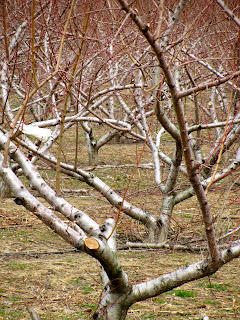My family has been going to the Ocean City, New Jersey for the beach since I was a little kid, living in South Jersey myself. My mother's family has been going to this town since the 1950's so it has a pretty dear place in our hearts. Given my own childhood of moving every three years, I'm especially fond of it, since I have memories of being there when I was three years old up until now, when I'm ___ years old!
Whenever we make the drive from the DC area, we pass through a lot of farmland, on Route 40, between the shore itself and the Delaware River Memorial Bridge. It's beautiful country and always reminds me more of the midwest than a place that's geographically a few hours' drive from DC, Baltimore, Philadelphia and New York. Most times, I'm making the drive by myself and feel too rushed to stop and snap pictures, but my mom and I were in the car together this last time and we began "Peachtree watch, Spring 11." Or something.
This orchard is just budding up and I'll post pictures of the trees' progress in the weeks to come. Even in winter it's beautiful. The silver hue of the old bark sparkles in a gray winter January landscape and the new growth is, well, peachy colored.
The genus itself,
Prunus should sound familiar. Just last
Sunday I posted on a far more recognizable species of
Prunus - the cherry tree. Also known as
Prunus x. yedoensis, Prunus serrulata, etc.
Indeed, cherries are more popular for ornamental purposes whereas peaches are mainly grown for producing fruit. The species name,
persica literally means "peach" in Latin. It was believed the plant was from Persia (Iran) but now we know that it is originally native to China but its origin became confused on its trip to Europe via the Silk Road.
Now then, as a former resident of Athens, Georgia, I will not contest the quality of Georgia or South Carolina peaches. I get it. But Jersey peaches are damn good. And of course ecologically, who doesn't want to buy local? The geology of the region lends itself to good produce (ergo the "Garden State") - low flat land with sandy soil and a high water table (typical for the Atlantic Coastal Plain) makes for good farming.
In fact, my family loves Jersey produce so much, we play a terrible game. Go to the farmer's stand and pick one thing. What do you get? For me, it's an easy game until I get down to the final three: tomatoes, blueberries and peaches. All delicious.
Though peaches do make the best pies.




























